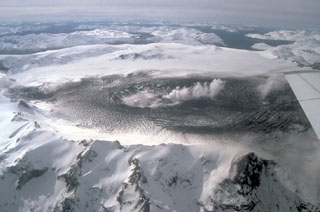Report on Cerro Hudson (Chile) — February 1995
Bulletin of the Global Volcanism Network, vol. 20, no. 2 (February 1995)
Managing Editor: Richard Wunderman.
Cerro Hudson (Chile) Sulfurous odors, noises, rising rivers, and thermal anomalies
Please cite this report as:
Global Volcanism Program, 1995. Report on Cerro Hudson (Chile) (Wunderman, R., ed.). Bulletin of the Global Volcanism Network, 20:2. Smithsonian Institution. https://doi.org/10.5479/si.GVP.BGVN199502-358057
Cerro Hudson
Chile
45.9°S, 72.97°W; summit elev. 1905 m
All times are local (unless otherwise noted)
On 15 February, inhabitants of the Huemules valley 40 km NW of Hudson heard noises coming from the volcano. The next day a sulfurous odor reached the city of Coihaique, 75 km NE of Hudson. The day after that (17 February), inhabitants of the Huemules valley again heard noises and smelled sulfur. Furthermore, the Huemules river rose such that its banks shifted laterally by 30-40 m from its normal course.
Based on an interpretation of a NOAA satellite image, personnel of the Centro de Estudios Espaciales de la Universidad de Chile reported a 10-km-diameter, 37°C thermal anomaly over the E sector of the caldera. Rodrigo Rodrigues (ONEMI) overflew the area on 21 February but saw no fresh ash upon the snow. He only saw minor fumarolic activity, mainly discharging steam. The steam escaped from part of crater 1, an area in the glacial ice cap along the W wall of the 9-km-diameter summit caldera (see BGVN 16:07-16:11).
As on 14 March 1994, this event may have generated phreatic explosions, local subglacial melting, and steam production, all possibly due to heat remaining from the 1991 eruptive cycle. Similar activity was also reported during 10-13 April 1993 and a rainy summer season in 1991-1992 caused extensive reworking of pyroclastic debris, particularly down the Huemules river (BGVN 17:03). Prior to the overflight, on 6 February 1995 a pilot flying near the Chile-Argentina border (close to Balmaceda, 45.52°S, 72.43°W) noted "strong volcanic activity." Since prevailing winds blow from the W, this might have been new ash from Hudson, but it also might have been dust or Hudson ash re-suspended from previous ground deposits.
Preliminary tephrochronology indicates that in the last 7,000 years Hudson has had at least 3 large magnitude eruptions (possibly in the VEI 4-6 range). Minor Plinian eruptions had a recurrence interval of 500 to 1,000 years (Stern and Naranjo, in press).
Hudson produced one of the largest eruptions of the 20th century starting on 8 August 1991 from a fissure cutting the caldera rim. The paroxysmal phase began on 12 August, sending columns up to 16-18 km for 3 days, resulting in ash fall on the Falkland Islands, 1,000 km away. Pyroclastic flows were mostly restricted to the caldera floor, and a lava flow traveled 4 km down the WNW flank following the glacier along the upper reaches of the Huemules valley. The eruption plume of 14-15 August was blown rapidly E by the Roaring Forties winds so that about 5-6 days later a "strange haze" arrived in Australia, 15,000 km E.
Reference. Stern, C.R., and Naranjo, J.A., in press, Summary of the Holocene eruptive history of the Hudson volcano, in Bitschene & Mendia (Eds.). The 1991 eruption of the Hudson volcano: a thousand days after, Naturalia Patagonica: Universidad Nacional de la Patagonia, Comodoro Rivadavia and Publicacion Series of the Argentianian Geological Survey, Buenos Aires, Argentina.
Geological Summary. The ice-filled, 10-km-wide caldera of Cerro Hudson volcano was not recognized until its first 20th-century eruption in 1971. It is the southernmost volcano in the Chilean Andes, related to subduction of the Nazca plate beneath the South American plate. The massive volcano covers an area of 300 km2. The compound caldera is drained through a breach on its NW rim, which has been the source of mudflows down the Río de Los Huemeles. Two cinder cones occur N of the volcano and others occupy the SW and SE flanks. This volcano has been the source of several major Holocene explosive eruptions. An eruption about 6,700 years ago was one of the largest known in the southern Andes during the Holocene; another eruption about 3,600 years ago also produced more than 10 km3 of tephra. An eruption in 1991 formed a new 800-m-wide crater in the SW portion of the caldera.
Information Contacts: Jose Antonio Naranjo, Servicio Nacional de Geologia y Mineria, Avenida Santa Maria 0104, Casilla 1347, Santiago, Chile.

